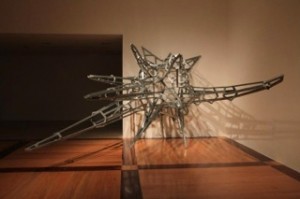[Slow Art Day has asked its 2013 hosts and volunteers to write short summaries of their own experiences looking slowly at artworks of their choosing.]
After looking around the Museo Marco, I chose the artwork The Fuck Off Project by Daniel Ruanova to examine patiently as part of the initiative of Slow Art Day. There were, no doubt, other pieces that called my attention, but the idea of examining this particular piece interested me the most. This artwork consists of a series of metallic rods that are assembled into a set of pointy extrusions. It almost looks like a “wire frame” (like those seen in animation programs) of the back of a porcupine.

Daniel Ruanova. The Fuck Off Project. 1976
At first glance the work certainly seemed aggressive. Although not insulting (at least until you read the title), I initially did not want to get near it. Each of the protrusions appear to be directed toward the viewer, independent of the viewing angle. Judging by the name, I thought that this was precisely the motive of the artist – i.e. to portray aggression. That made me think of similar shaped things in nature that convey the exact same defensive idea, like pufferfish or the porcupine, and I concluded that the artist may have been inspired by such animals.
Despite my apprehension, I decided to slowly approach the piece. As I got nearer, I noticed that the feeling of aggression became stronger. I decided to actually walk into it and that changed my experience of the piece completely. There, inside it, I felt protected. The metallic arms were no longer pointed towards me but towards everyone else. It’s as if now their sole purpose was my defense. I sat down to be able to immerse myself deeper, and, as expected, the sense of security was intensified. There, in the midst of all those metal rods, I felt comfortable.
The next thing I noticed was the facial expressions of the people in the museum when they noticed me there. Assuming they shared the feeling I had felt while looking at the sculpture from the outside, I could understand why. I sat there for awhile, watching people pass looking bewildered.
I now understand the Slow Art Day initiative in a better way and can see how slow looking can really transform the experience. Looking slowly and taking the time to move in and around this artwork completely changed my perception – and – this insightful episode reaffirmed my decision to be a host during the Slow Art Day for Museo Marco in Monterrey on April 27.
– David Zambrano Reyes, Volunteer at MARCO
[Make sure to check out Museo MARCO’s Slow Art Day event in Monterrey, Mexico.]


